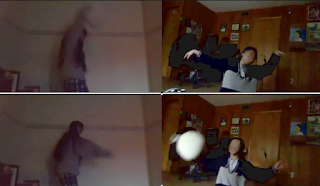We only had time for four choreography projects for the Jazz 1 (Beginning dance) class, owing to the 4x3 schedule and having to condense the entire year’s curriculum into one semester. For the third project I wanted to give them a version of the project that is usually our fall semester final – contrasts in tempo, level, and size/range. I usually introduce this one with a quote from Doris Humphrey about staying away from “the deadly middle.” In this situation, I figured that three elements in one project was really too much for Zoom, so I concentrated on the two that we hadn’t already covered (tempo and size/range). Unfortunately, even the two different elements made life too complicated for our distance learning world, as this was our least successful project – only a few groups truly showed what I would consider real contrasts or opposites in both tempo and size… perhaps showing real size contrasts is just too much for small spaces! So this is the only project I plan to change for my 4th-period Jazz 1 class, which meets during the spring semester – I think I will revert to the simple tempo variations project which is usually the lead-up to the contrasts final when we are in person.
Difficult third project notwithstanding, I was not about to let go of our usual year-end final: narrative form. This one is important to me, as it really helps set the students up for the idea that creating dances is not just about creating interesting steps, but is also a form of communication… I set this one up the usual way, with a video observation of a few short narrative dances or excerpts: a large chunk of Paul Taylor’s Snow White, the final crypt scene from Romeo and Juliet (I have the ABT version, with Natalia Makarova), and the “Rosa Parks” section of Gordon Parks’ Martin. Then I just set them in groups (in this case, in breakout rooms) with the instructions that they are to use movement only to tell a story – whether a famous story that we all know (like Snow White or Romeo and Juliet), something from history (like Rosa Parks), something from their own lives, or something they make up. I remind them that a real story has a beginning, a middle, and an end, and something has to actually happen – but beyond that they are free to create whatever story they would like.
Of course, the added difficulty this year is that it is so much harder to tell a story when none of the dancers are in the same place… But some of the groups came up with very creative solutions to the problem of narrative on Zoom! One duet used a bear costume
and multiple virtual screens to dance Goldilocks and the three bears. Another pair created a story about a girl drowning in the ocean and getting saved, and managed to throw the life-preserver (actually a big round pillow that they both had in their houses) from one screen to the next. And a quartet used extensive (and well-planned) video editing to tell the story of Cinderella – my favorite part was how they took advantage of two of the dancers having similar staircases in their houses, so that Cinderella could lose her shoe in one scene and the prince could find a shoe on (what appeared to be) the same staircase in the next scene! There was much creativity all around, and I was so happy that they finished the semester this way!
thoughts on dance education and life... where I hope to explore issues and questions around dance education, tell stories from my years of teaching practice and the lessons that I have learned... and perhaps generate some conversation.
Friday, March 5, 2021
more choreography projects on Zoom
Subscribe to:
Post Comments (Atom)



No comments:
Post a Comment